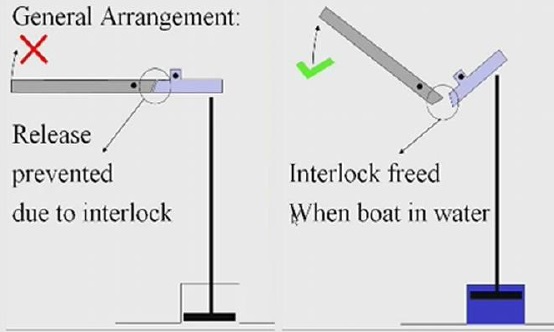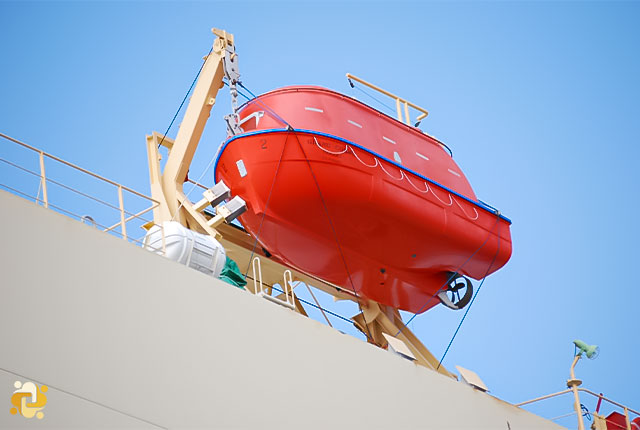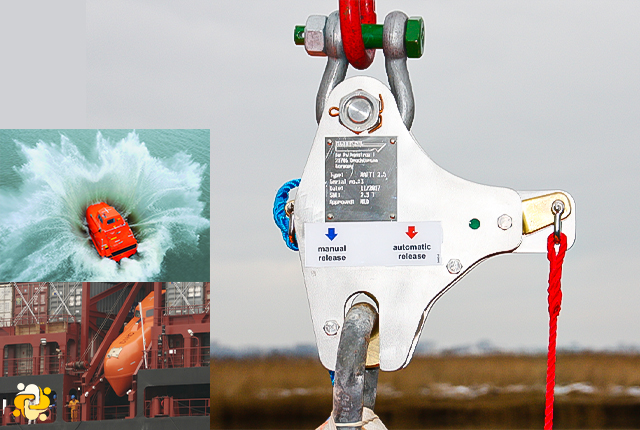
Lifeboat releasing mechanisms
2022-05-29 19:52
There are different types of lifeboats used on board a ship on the basis of the type of ship and other special requirements. Not all the lifeboats have the same type of releasing mechanisms, for the launching of a lifeboat depends on several other factors. In this article, we will take a look at the main types of “lifeboat releasing mechanisms”.
Types of lifeboat releases
There are two types of lifeboat releasing mechanisms “on-load” and “off-load”. These mechanisms release the boat from the davit, which is attached to a wire or fall by means of a hook. By releasing the hook, the lifeboat can be set free to propel away from the ship.
Off-Load Mechanism
The original ‘off-load’ hook is of 19th century design. It was intended to permit manual release only when the lifeboat was fully waterborne and all weight was off the davit block hooks. It was simple and worked well if a lifeboat was launched in more or less perfect conditions i.e. from a vessel stopped in calm seas.
There is a hydrostatic piston unit provided at the bottom. the piston is connected to the operating lever via a link. As the ship becomes waterborne, the water pressure will move the hydrostatic piston up. The piston will continue to move up, pushing the lever and as a result, it will operate the hook arrangement releasing the fall wire. There is a safety pin arrangement provided near the clutch box, which disables the offload release (in case of rough weather or hydrostatic piston malfunction) allowing the operator to perform on-load release of the lifeboat.
Such placid conditions rarely exist when abandoning ship and this resulted in numerous accidents and fatalities while attempting to disconnect the ‘off-load’ hooks.
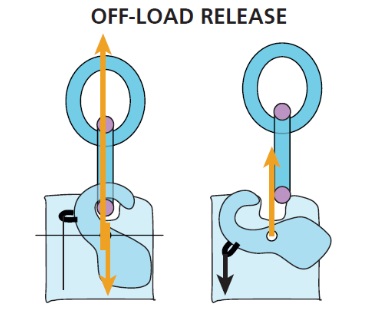
On-Load Mechanism
The high incidence of ‘off-load’ hook accidents motivated the creation of the ‘on-load’ release hook and the phasing in of its SOLAS mandated utilization.
The ‘on-load’ hook was designed to allow the lifeboat crew to release both davit hooks simultaneously before the boat was fully waterborne in either calm or heavy seas and even if the launching vessel had not come to a full stop. The provision of these capabilities required complex engineering to accomplish with up to 88 different designs being tested and ultimately approved by the IMO.
The load will be still in the fall as the boat would not have touched the water. Normally the on-load release is operated when the boat is about to touch the surface of the water so that the fall is smooth without damaging the boat and harming the crew inside. A lever is provided inside the boat to operate this mechanism. As the lever is operated from inside, it is safe to free the boat without going out of the lifeboat, when there is a fire on the ship.
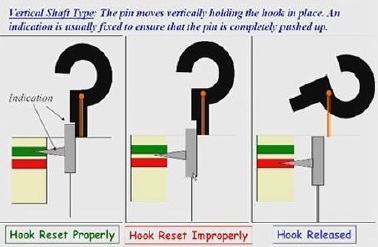
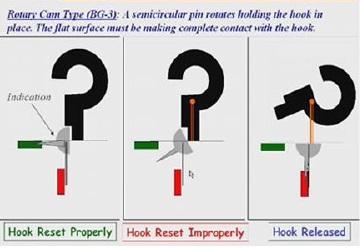
The aforementioned investigative process resulted in what might be described as an IMO ‘recall and upgrade’ as stipulated by MSC.1/Circ.1392. This required that all of the original, or Mark 1*, ‘on-load’ release hooks that had been installed to be subjected to a mandatory evaluation by the manufacturer. It also required that all Mark 1 ‘on-release’ hooks be either upgraded or replaced with Mark 2* ‘on-load release hooks to MSC.1/Circ.1392 standards. Finally, it required that Fall Preventer Devices (FPDs) be fitted to lifeboats until such time as the ‘on load’ release hooks were upgraded or replaced and then tested as being compliant with the Life Saving Appliance (LSA) Code as amended by MSC.320(89).
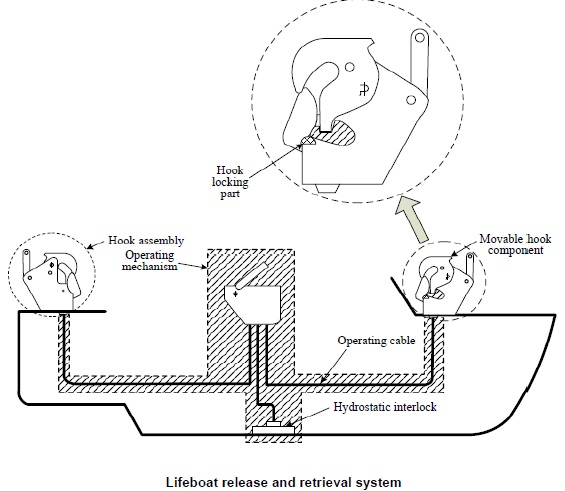
Free Fall lifeboat release
In Free fall lifeboat, the launching mechanism is similar to on load release. the only difference is that the freefall lifeboat is not lowered till 1m above water level, it is launched from the stowed position by operating a lever located inside the boat which releases the boat from rest of the davit and boat slides through the tilted ramp into the water.
SOLAS & LSA Code Requirement
Every lifeboat to be launched by a fall or falls, except a free-fall lifeboat, shall be fitted with a release mechanism complying with the following requirements subject to subparagraph .17 below:
- the mechanism shall be so arranged that all hooks are released simultaneously;
- notwithstanding subparagraph .7.2 the mechanism shall only open when the release mechanism is operated with the boat fully waterborne or, if the boat is not waterborne, by multiple, deliberate and sustained action which shall include the removal or bypassing of safety interlocks designed to prevent premature or inadvertent release;
- the mechanism shall not be able to open due to wear, misalignment and unintended force within the hook assembly or operating mechanism, control rods or cables as may be connected to, or form part of the hook assembly and with trim of up to 10º and a list of up to 20º either way; and
- the functional criteria of 4.4.7.6.2 and 4.4.7.6.2.1 apply for the range of loads, representing 0% to 100% of the safe working load of the lifeboat release and retrieval system for which it may be approved;
- unless a release mechanism is of the load over center type, which is held fully closed by the weight of the lifeboat, the hook assembly shall be designed so that the moveable hook component is kept fully closed by the hook locking parts capable of holding its safe working load under any operational conditions until the hook locking part is deliberately caused to open by means of the operating mechanism. For designs utilizing the tail of the movable hook component and cam either directly or indirectly securing the tail of the movable hook component, the hook assembly shall continue to be closed and hold its safe working load through rotation of the cam of up to 45 degrees in either direction, or 45 degrees in one direction if restricted by design, from its locked position;
Note: Cam type: a method utilizing the cam shaft to either directly or indirectly securing the tail of the movable hook component; - to provide hook stability, the release mechanism shall be designed so that, when it is fully reset in the closed position, the weight of the lifeboat does not cause any force to be transmitted to the operating mechanism;
- locking devices shall be designed so that they cannot turn to open due to forces from the hook load; and
- if a hydrostatic interlock is provided, it shall automatically reset upon lifting the boat from the water.
- the mechanism shall have two release capabilities: normal (off-load) release capability and on-load release capability:
- normal (off-load) release capability shall release the lifeboat when it is waterborne or when there is no load on the hooks, and not require manual separation of the lifting ring or shackle from the jaw of the hook; and
- on-load release capability shall release the lifeboat with a load on the hooks. This release mechanism shall be provided with a hydrostatic interlock unless other means are provided to ensure that the boat is waterborne before the release mechanism can be activated. In case of failure or when the boat is not waterborne, there shall be a means to override the hydrostatic interlock or similar device to allow emergency release. This interlock override capability shall be adequately protected against accidental or premature use. Adequate protection shall include special mechanical protection not normally required for off-load release, in addition to a danger sign. The protection shall be deliberately destroyed by applying a suitable minimum force, for instance by breaking a protection glass or translucent cover. A label or thin wire seal is not considered sufficiently robust. To prevent a premature on-load release, on-load operation of the release mechanism shall require multiple, deliberate and sustained action or actions by the operator;
- to prevent an accidental release during recovery of the boat, unless the hook is completely reset, either the hook shall not be able to support any load, or the handle or safety pins shall not be able to be returned to the reset (closed) position, and any indicators shall not indicate the release mechanism is reset. Additional danger signs shall be posted at each hook station to alert crew members to the proper method of resetting;
- all components of the hook unit, release handle unit, control cables or mechanical operating links and the fixed structural connections in a lifeboat shall be of material corrosion resistant in the marine environment without the need for coatings or galvanizing. Design and manufacturing tolerances shall be such that anticipated wear throughout the service life of the mechanism shall not adversely affect its proper functioning. Mechanical operating links such as control cables shall be waterproof and shall have no exposed or unprotected areas;
- the release mechanism shall be so designed and installed that crew members from inside the lifeboat can unambiguously determine when the system is ready for lifting by:
- directly observing that the movable hook portion or the hook portion that locks the movable hook portion in place is properly and completely reset at each hook; or
- observing a non-adjustable indicator that confirms that the mechanism that locks the movable hook portion in place is properly and completely reset at each hook; or
- easily operating a mechanical indicator that confirms that the mechanism that locks the movable hook in place is properly and completely reset at each hook;
- clear operating instructions shall be provided with a suitably worded warning notice using color coding, pictograms, and/or symbols as necessary for clarity. If color coding is used, green shall indicate a properly reset hook and red shall indicate danger of improper or incorrect setting;
- the release control shall be clearly marked in a color that contrasts with its surroundings;
- means shall be provided for hanging-off the lifeboat to free the release mechanism for maintenance;
- the load-bearing components of the release mechanism and the fixed structural connections in the lifeboat shall be designed with a calculated factor of safety of 6 based on the ultimate strength of the materials used, and the mass of the lifeboat when loaded with its full complement of persons, fuel and equipment, assuming the mass of the lifeboat is equally distributed between the falls, except that the factor of safety for the hanging-off arrangement may be based upon the mass of the lifeboat when loaded with its full complement of fuel and equipment plus 1,000 kg; and
- a hydrostatic interlock shall be designed for a factor of safety of not less than 6 times maximum operating force based on the ultimate strength of the materials used;
- the operating cables shall be designed for a factor of safety of not less than 2.5 times maximum operating force based on the ultimate strength of the materials used; and
- where a single fall and hook system is used for launching a lifeboat or rescue boat in combination with a suitable painter, the requirements of paragraphs 4.4.7.6.7, 4.4.7.6.8 and 4.4.7.6.15 need not be applicable; in such an arrangement a single capability to release the lifeboat or rescue boat, only when it is fully waterborne, will be adequate.
